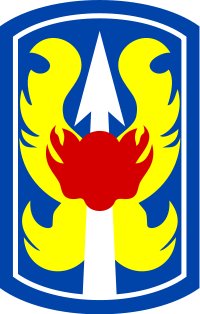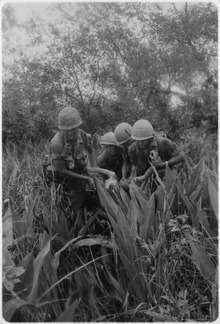199th Infantry Brigade (United States)
The 199th Infantry Brigade (Light) is a unit of the United States Army which served in the Army Reserve from 1921–1940, in the active army from 1966 to 1970 (serving in the Vietnam War), briefly in 1991–1992 at Fort Lewis, and from 2007 as an active army training formation at Fort Benning.
| 199th Infantry Brigade | |
|---|---|
 Shoulder sleeve insignia of the 199th Brigade. | |
| Active | 1921–1940 1966–1970 1991–1992 2007 – present |
| Country | |
| Branch | |
| Type | Infantry |
| Role | Training |
| Size | Brigade |
| Garrison/HQ | Fort Benning |
| Nickname(s) | The Redcatchers |
| Motto(s) | Light, Swift, Accurate |
| Engagements | Vietnam War |
| Insignia | |
| Distinctive unit insignia |  |
Early history
The brigade was first formed in the West Virginia Organized Reserve in 1921, as part of the 100th Infantry Division. It incorporated the 398th and 399th Infantry Regiments. However, with the reorganisation of the Army from four-regiment to three-regiment divisions as World War II approached, the brigade was disbanded in 1940.
Vietnam War

The unit was formed for the second time. It trained at Fort Benning, Georgia and Camp Shelby, Mississippi from September to November 1966 in preparation for deployment to Vietnam from Fort Benning, Georgia. The 199th was the only combat unit to train at Camp Shelby during the Vietnam War.
Nicknamed "the Redcatchers", the unit was hastily moved to Sông Bé, Vietnam on 10 December 1966 to provide an increased U.S. presence in the III Corps Tactical Zone and remained there until its return to Fort Benning on 11 October 1970, where it was inactivated.[1] The unit was briefly reactivated at Fort Lewis Washington from the remains of the 9th Infantry Division.
The brigade was conducting Operation Uniontown in Đồng Nai Province when the 1968 Tet Offensive began. It immediately began a defense of U.S. II Field Force headquarters at Long Binh Post against attacks by the VC 275th Regiment. One battalion was moved by helicopter to attack a Viet Cong command post at the Phu Tho racetrack inside Saigon, then engaged in house-to-house fighting in Cholon.[1]
During 1969, the 199th was responsible for the security of the region north and east of the capital, and in 1970 moved into the "Iron Triangle" when other units participated in the Cambodian Incursion.[1]
- Units assigned to the 199th Infantry Brigade (Light):[1]
- Brigade infantry
- 2nd Battalion, 3rd Infantry
- 3rd Battalion, 7th Infantry
- 4th Battalion, 12th Infantry
- 5th Battalion, 12th Infantry
- Brigade artillery
- 2nd Battalion, 40th Artillery
- Brigade reconnaissance
- Troop D, 17th Cavalry (Armored)
- Company F, 51st Infantry (Long Range Patrol)
- Company M, 75th Infantry (Ranger)(Airborne)
- Brigade support
- 7th Support Battalion
- 179th Military Intelligence Detachment
- 87th Engineer Company
- 313th Signal Company
- 152nd Military Police Platoon
- 44th military history detachment
- 503rd Chemical Detachment
- 856th Radio Research Detachment (Army Security Agency)
- 40th Public Information Detachment
- Other units on temporary duty
- Brigade infantry
- Casualties
- 754 killed in action
- 4,679 wounded in action
Recent history
During the drawdown of the 9th Infantry Division at Fort Lewis in 1991–1992, a residual brigade, based around the division's 3rd Brigade, was briefly active as the 199th Infantry Brigade (Motorized) from 16 February 1991[2] before being reflagged on 16 July 1992 as the 2nd Armored Cavalry Regiment.
The structure of 199th Infantry Brigade at that time was:
- 199th Infantry Brigade (Motorized), Fort Lewis
- Headquarters & Headquarters Company
- 1st Battalion, 33rd Armor[3]
- 2nd Battalion, 1st Infantry[4]
- 3rd Battalion, 47th Infantry[5]
- 1st Battalion, 11th Field Artillery[6]
- 99th Support Battalion (Forward)
- Troop A, 9th Cavalry (rest of 2nd Squadron, 9th Cavalry disbanded on the same date)
- 102nd Engineer Company (Company D, 15th Engineer Battalion)
- 9th Chemical Company[7]
- Battery E, 44th Air Defense Artillery[8]
On 27 June 2007, the 11th Infantry Regiment was reflagged as the 199th Infantry Brigade at Fort Benning. In October 2013, the brigade underwent changes to its task organization as part of restructuring within the Maneuver Center. The brigade was designated as the Leader Development Brigade and reorganized to contain both Armor and Infantry BOLC, OCS, and the MCCC.
- Units assigned to the 199th Infantry Brigade:
- HHC, 199th Bde (Maneuver Captains Career Course Detachment)
- 2nd Battalion, 11th Infantry Regiment (Infantry Basic Officer Leader Course (IBOLC))
- 3rd Battalion, 11th Infantry Regiment (Officer Candidate School)
- 2nd Squadron, 16th Cavalry Regiment (Armor Basic Officer Leaders Course (ABOLC))
The 2nd Squadron, 16th Cavalry Regiment is commanded by Lieutenant Colonel Franz Rademacher. Troops within the squadron, excluding the Headquarters and Headquarters Troop, are organized to associate with Armor Basic Officer Leaders Course (ABOLC) classes of the United States Army Armor School. The four troops are Hawk Troop, Ironhorse Troop, Killer Troop, and Lightning Troop. The Headquarters and Headquarters Troop is responsible for, among other tasks, the training of lieutenants who are awaiting their ABOLC class or who have completed the course and are awaiting follow-on orders. Headquarters and Headquarters Troop is also responsible for the certification of all instructors at the Armor Basic Officer Leadership Course. Each instructor is initially certified in the U.S. Army Basic Instructor Course, and then must undergo specific instruction to learn the doctrine that is taught to the Armor and Cavalry lieutenants. ABOLC is the introductory skills course for United States Army Cavalry and Armor second and first lieutenants. These officers, recent graduates of the United States Military Academy, ROTC programs, and Officer Candidate School, receive eighteen weeks of training in basic soldiering skills, maneuver tactics, troop- and company-level strategy, and logistical planning. ABOLC consists of three phases - the first focusing on individual soldier skills; Phase II focusing on platform and crew training; and Phase III focusing on tactics and field training. The final exercise, the Competitive Maneuver Exercise (CME), is a strenuous seven-day problem-solving exercise which evaluates a students ability to demonstrate proficiency in cumulative course outcomes. Students are evaluated based on their performance during each exercises, and rotate among every position within a platoon and troop. The course is taught by officers, non-commissioned officers, and civilians from the 2nd Squadron, 16th Cavalry Regiment of the 199th Infantry Brigade. The 2nd Squadron, 16th Cavalry currently operates out of Harmony Church in Fort Benning, Georgia.
In popular culture
Michael Lee Lanning, a retired lieutenant colonel, served a tour in Vietnam with the Redcatchers as a lieutenant. He reported to Vietnam where as a second lieutenant he served as an infantry platoon leader and reconnaissance platoon leader. After his promotion to first lieutenant, he commanded a rifle company, Bravo Company of the 2d Battalion, 3d Infantry. He wrote two books about his experiences there: The Only War We Had: A Platoon Leader's Journal of Vietnam (New York: Ivy Books/Random House, 1987); and Vietnam 1969-1970: A Company Commander's Journal (New York: Ivy Books/Random House, 1988).
Notes
- Stanton, p 89
- Dinackus 2000, page 11-3.
- "1st Squadron, 33rd Cavalry Regiment Lineage". US Army Center of Military History. Retrieved 21 June 2020.
- "2nd Battalion, 1st Infantry - Lineage and Honors". US Army Center of Military History. Retrieved 21 June 2020.
- "3rd Battalion, 47th Infantry - Lineage and Honors". US Army Center of Military History. Retrieved 21 June 2020.
- McKenney, Janice E. "Field Artillery - Army Lineage Series - Part 1" (PDF). US Army Center of Military History. Retrieved 21 June 2020.
- "9th Chemical Company - Lineage and Honors". US Army Center of Military History. Retrieved 21 June 2020.
- "1st Battalion, 44th Air Defense Artillery - Lineage and Honors". US Army Center of Military History. Retrieved 21 June 2020.
References
- Stanton, Shelby L. (1987). Vietnam Order of Battle. Galahad Books, New York, New York. ISBN 978-0-671-08159-1.
- "The Brigade: A History, Its Organization and Employment in the US Army"
- 199th Infantry Brigade Home Page